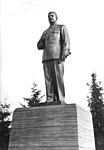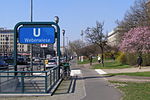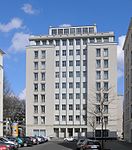Cemetery of the March Fallen

The Cemetery of the March Fallen is a cemetery in Volkspark Friedrichshain in the Berlin district of Friedrichshain. It was laid out for the victims of the March Revolution of March 18, 1848, the March Fallen. In 1925, the Berlin architect Ludwig Hoffmann redesigned the park and gave it its existing three-sided shape. Further redesigns took place in 1948 and 1957. After the November Revolution of 1918, the first Berlin soldiers who died in the uprising were also buried here, as commemorated by the bronze statue of the Red Sailor by Hans Kies, which was erected in 1960. In 1948, a memorial stone with the names of those who died in the March uprising was erected to mark the cemetery's 100th anniversary. Today there are still 18 gravestones, three iron grave crosses, a stele and two cast iron memorials. The cemetery of the March soldiers is now a memorial and garden monument. A total of 255 March soldiers and 33 soldiers of the November Revolution rest in the cemetery.
Excerpt from the Wikipedia article Cemetery of the March Fallen (License: CC BY-SA 3.0, Authors, Images).Cemetery of the March Fallen
Ernst-Zinna-Weg, Berlin Friedrichshain
Geographical coordinates (GPS) Address External links Nearby Places Show on map
Geographical coordinates (GPS)
| Latitude | Longitude |
|---|---|
| N 52.5246 ° | E 13.4367 ° |
Address
Friedhof der Märzgefallenen
Ernst-Zinna-Weg
10249 Berlin, Friedrichshain
Germany
Open on Google Maps











